Table of Contents
The Five Kingdom classification is a biological system used to categorize and organize living organisms. The five kingdom classification was introduced by biologist Robert Whittaker in 1969. It categorizes living organisms into five kingdoms: Kingdom Monera (Bacteria and Cyanobacteria), Kingdom Protista (Unicellular Eukaryotes), Kingdom Fungi (Fungi and Yeast), Kingdom Plantae (Plants), and Kingdom Animalia (Animals). However, this system has been refined over time, and modern classification now often uses three domains: Bacteria, Archaea, and Eukarya. Here in the article, we will briefly discuss the Kingdom Monera.
Definition of Kingdom Monera
The kingdom monera, within the older five-kingdom classification system, includes prokaryotic organisms such as bacteria. These organisms are characterized by their lack of membrane-bound nuclei and other membrane-bound cell organelles. Monera includes a wide variety of bacteria with diverse shapes, sizes, and metabolic processes.

They can be found in various environments, including soil, water, and the bodies of other organisms. Some bacteria are beneficial, playing roles in nutrient cycling and digestion. while others can cause diseases. Keep in mind that Monera kingdom classification is not commonly used in modern taxonomy, which has shifted to a three-domain system.
Kingdom Monera Diagram
A comprehensive, diagram of the kingdom Monera has been shown below. It typically encapsulated its fundamental characteristics and divisions. This diagram shows two primary divisions within the kingdom, Bacteria and Archaea.
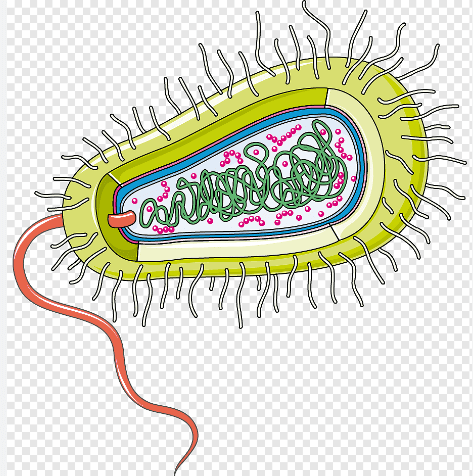
Characteristics of Kingdom Monera
The kingdom Monera includes bacteria and archaea and has several characteristic features. But remember that the classification of organisms has evolved, and the term “kingdom Monera” might not be used in more recent taxonomic systems.
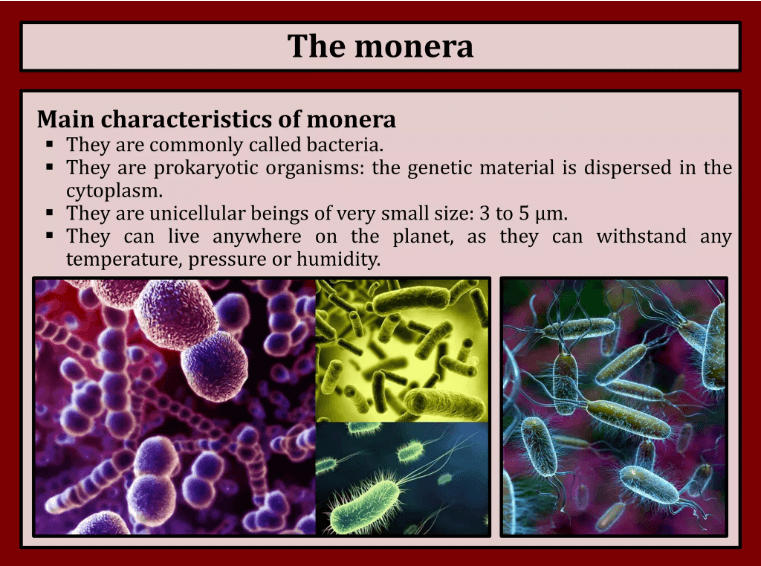
- Prokaryotic Cells: Monera organisms lack a true nucleus and membrane-bound cell organelles, making them prokaryotic cells.
- Unicellular: Most monera species are unicellular, although some form clusters or colonies.
- Cell Wall: They typically have a cell wall made up of peptidoglycan, which provides structure and protection.
- Reproduction: Monera reproduces primarily through binary fission, a form of asexual reproduction.
- No Sexual Reproduction: Sexual reproduction is absent in monera, but there are mechanisms for horizontal gene transfer, like conjugation. transformation, and transduction.
- Lack of Organs: Since they are unicellular, monera lack specialized organs or tissues.
- Small Size: Most monera species are microscopic, though they exist in a staggering variety of shapes and sizes.
- Archaea Distinctiveness: Archaea, a subgroup within Monera, are known for their ability to thrive in extreme environments like acidic hot springs or deep-sea hydrothermal vents.
Kingdom Monera Classification
There were three major classifications (Eubacteria, Archaebacteria, and Cyanobacteria) within the former Kingdom Monera. It is important to note that these classifications were based on morphology and structural characteristics, and our understanding of microbial diversity has expanded significantly since then due to advances in genetics and molecular biology. As a result, the traditional classification of the kingdom Monera has been revised, and organisms are now categorized in a more intricate and nuanced manner based on their genetic relationships and evolutionary history.
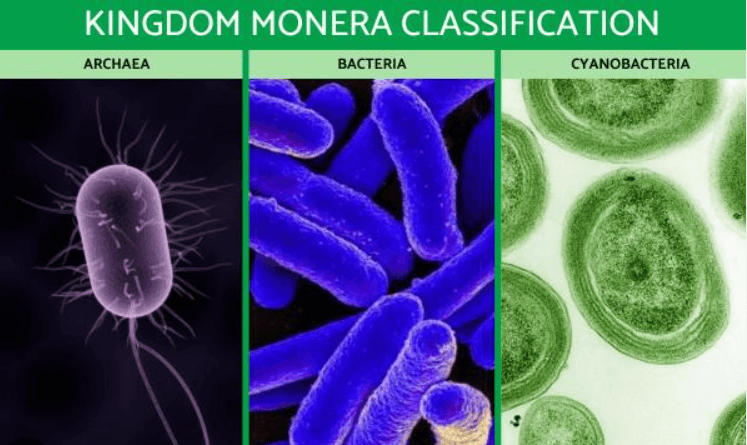
| Classification of Kingdom Monera | |
| Classifications | Description |
| Eubacteria | Eubacteria, are diverse, prokaryotic microorganisms with a wide range of roles, from beneficial symbiosis to pathogenic infections. |
| Archaebacteria | These bacteria are distinct from eubacteria and are ancient prokaryotes inhabiting extreme environments, offering insights into early life and adaptation. |
| Cyanobacteria | Cyanobacteria are photosynthetic bacteria that produce oxygen and play a key role in Earth’s ecosystem and carbon cycle. |
Eubacteria
Eubacteria, also known as true bacteria, are the most common and diverse group within the former kingdom Monera. The Eubacteria have cell walls made up of Peptidoglycan, which gives them their characteristic shape and structure. Eubacteria can be divided into various groups based on factors like their shape (cocci, bacilli, spirilla), staining characteristics (Gram-positive or Gram-negative), and metabolic processes.
Bacteria
Single-celled microorganisms popularly known as Bacteria can be found almost everywhere on Earth. They can be both beneficial and harmful. Some bacteria are essential for processes like digestion, while others can cause infections or diseases. These bacteria are found in many different shapes, such as Coccus, Bacilli, Spirilla, Vibrio, etc. These shapes have been explained in the form of a table below.
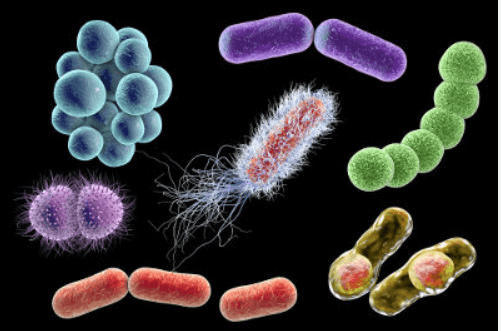
| Shapes of Eubacteria or True Bacteria | |
| Shapes | Description |
| Coccus (plural: Cocci) | These bacteria are spherical or oval-shaped. They occur singly, in pairs (diplococci), in chains (streptococci), or in clusters (staphylococci). |
| Bacillus (plural: Bacilli) | Bacilli are rod-shaped bacteria. The Bacillus may be short or long, and they might occur singly or in chains. |
| Spirillum (plural: Spirilla) | Spirillum are spiral-shaped bacteria. The spirillum has a helical or corkscrew-like shape. |
| Vibrio | Vibrio are comma-shaped bacteria with a curved appearance. |
| Coccobacillus | These bacteria are somewhat intermediate in shape between cocci and bacilli, appearing as oval or rod-like forms. |
| Filamentous | Some bacteria can form long filament-like structures. They may appear as a chain of cells within a thread-like structure. |
| Stalked | These bacteria exhibit a slender body with a stalk that extends from the cell, aiding in attachment and nutrient absorption. |
| Budded | Budded eubacteria have small protrusions, or “buds”, emerging from the parent cell, eventually detaching to form new cells. |
Archaebacteria (Archaea)
Archaea are a distinct group of prokaryotic microorganisms that were originally classified as bacteria but were later reorganized as being fundamentally different. The cell walls of Archaebacteria lack peptidoglycan, and they have unique molecular and genetic characteristics that set them apart from both bacteria and eukaryotes. Archaea often inhabit extreme environments like hot springs, salt flats, and hydrothermal vents, but they can also be found in more moderate habitats.
Cyanobacteria (Blue-Green Algae)
Cyanobacteria are a type of bacteria that are capable of performing the process of photosynthesis. The cyanobacteria were once classified within Monera but are now often categorized as a separate group due to their ability to perform oxygenic photosynthesis, which is similar to the process used by plants. Cyanobacteria have pigments that allow them to capture light energy and convert it into chemical energy, producing oxygen as a byproduct.
Examples of Kingdom Monera
The kingdom monera, which used to be a classification for bacteria, has been recognized into two domains: Bacteria and Archaea. Some examples of both bacteria and archaea are mentioned below.
- Bacteria: Some examples of bacteria are discussed below:
- Escherichia Coli (E.coli): Commonly found in the intestines of humans and animals, some strains of E. coli are harmless, while others can cause foodborne illnesses.
- Streptococcus: A genus of bacteria known for causing infections, such as strep throat and certain types of skin infections.
- Salmonella: This bacteria can cause food poisoning, leading to symptoms like vomiting, diarrhea, and stomach cramps.
- Bacillus Subtilis: A bacterium used as a model organism in research due to its ability to form spores and its genetic tractability.
- Lactobacillus Acidophilus: A beneficial bacterium found in the human gut, often used in probiotics supplements and dairy fermentation.
- Mycobacterium Tuberculosis: The causative agent of tuberculosis, a serious respiratory disease affecting the lungs.
- Archaea: Some examples of archaea are discussed below:
- Methanobacterium: These archaea produce methane gas a metabolic byproduct. They are often found in anaerobic environments like swamps and digestive systems of animals.
- Halobacterium: These archaea thrive in extremely salty environments such as salt slats or salt mines.
- Thermococcus: Found in deep-sea hydrothermal vents, Thermococcus archaea can survive and thrive in high-temperature environments.
- Pyrolobus fumarii: Known for its ability to survive in extreme heat, this archaeon was discovered near a hydrothermal vent.
- Methanosarcina mazei: Another type of methanogen, these archaea are involved in the process of converting organic matter into methane gas.
- Sulfolobus Acidocaldarius: Thriving in acidic, high-temperature environments like volcanic hot springs, these archaea are often used in biotechnology applications.
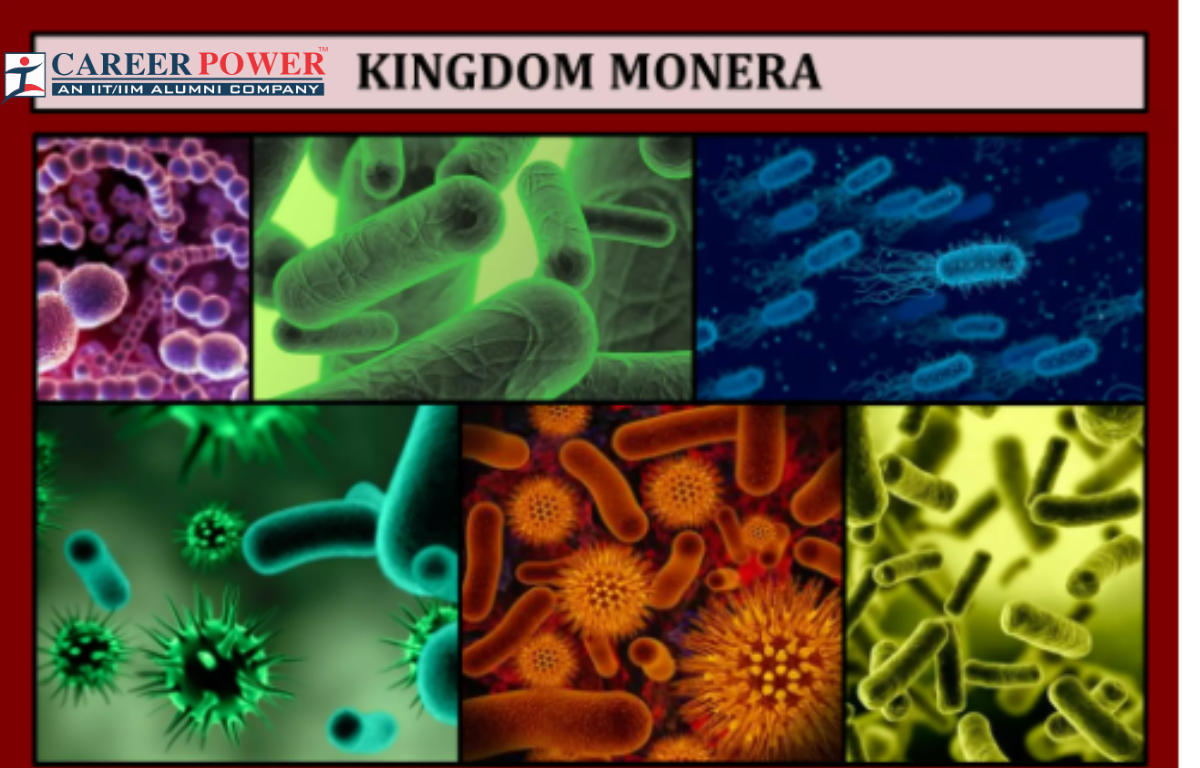
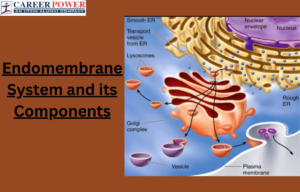 Endomembrane System - All the Organelle ...
Endomembrane System - All the Organelle ...
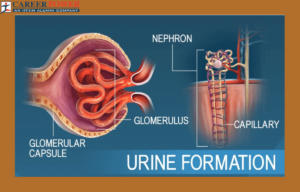 Urine Formation, Function of Tubules, Os...
Urine Formation, Function of Tubules, Os...
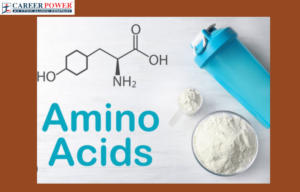 Amino Acids - List, Properties, Function...
Amino Acids - List, Properties, Function...
